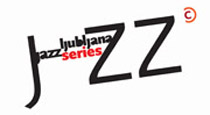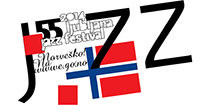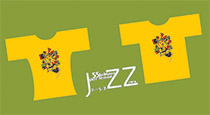56th Ljubljana Jazz Festival
1.–4. July 2015
The oldest European Jazz Festival focuses on guitar sounds and large ensembles. James Blood Ulmer's 75th anniversary will be celebrated with his solo concert. In addition, the festival will feature guitarists and composers Joe Morris, Terje Rypdal, Kalle Kalima, Igor Bezget just to name few. Also featured are Flat Earth Society, Fire! Orchestra, Carate Urio Orchestra and Carlos Bica Trio Azul all with new works. Another programme highlights are Sly & Robbie meet Nils Petter Molvaer; Diogo Nogueira’s and Hamilton de Holanda’s Bossa Negra and the world premiere of Mats Gustafsson & Craig Taborn duo.
Within the scope of four days, the jubilee 55th Ljubljana Jazz Festival offered a broad array of jazz and jazz-related styles. Although previously the focus selected by the festival’s co-directors, Bogdan Benigar and Pedro Costa, spotlighted an instrument (trumpet) or a legendary musician (Peter Brötzmann), this year’s festival featured two focuses, both of which, Norwegian jazz and jazz piano, gave an exemplary performance. The pianists presented a range of diverse techniques that testified to the instrument’s (the piano has formed an integral part of the jazz idiom since its inception) wide spectre of possibilities in jazz, while the Norwegians provided a valuable insight into this Scandinavian country’s prolific creative output.
We heard three Norwegian line-ups, Jaga Jazzist, Cortex and In the Country. The last named also featured the piano, which formed the core of the slowly unravelling music, partly associated with the sound of the ECM label, but the threesome added electronica as well as art-rock and post-rock influences to their fragile, meditative sound. The gig also featured a video that was projected onto the Linhart Hall’s backdrop. If listening to the trios’ albums it seems that their music offers an insight into numerous impressionistic landscapes, expanses envisaged rather than encountered, the live performance by the threesome translated them into an exhilarating and multicoloured experience, a vibrant blast of music. Jaga Jazzist also imbues jazz texture with elements of electronica and rock, but much more liberally than In the Country. The sound of Jaga Jazzist blends jazz, electronica and rock, be it in a singular composition or the band’s original idiom in general. As they skilfully navigated among genres, the playful and high-spirited collective shifted the focus among its members – from the vigorous and occasionally edgy “rock” rhythm section, and psychedelic electronic passages to rapturous and jazzy reed-blowing segments. Instead of experimenting with non-jazz styles, the Cortex, a so-to-speak classical jazz quartet (sax, trumpet, double bass and drums), preferred to explore African as well as oriental melodies, subtly embedding them into a forceful and modern sound that strongly resembles dance-floor jazz.
While Jaga Jazzist undoubtedly met the expectations of its audiences, from electronica enthusiasts to alternative rock buffs, the lovers of soul and jazz ballads were doubtlessly satisfied with the concert by a Grammy award-winner, Gregory Porter, who delivered his contemporary vision of jazz, soul and gospel at the sold-out Križanke theatre and won the hearts of the listeners. Porter’ back-up band was more than excellent (with the spotlight on sax player Yosuke Sato and his piercing solos), skilfully complementing Porter’s range of vocal registers, from the strong, entrancing baritone to slight nasal intonations in an emotional theme. Played to a reliable backing accompaniment, Gregory Porter’s songs, be it odes to love and sensuality or socially engaged compositions, recreated the genuine and easy-going atmosphere of a club.
The piano focus features quite a few concerts that rank among the festival’s finest. The doyen of German jazz, Joachim Kühn demonstrated his excellence at both of his appearances, the Joachim Kühn / Majid Bekkas / Ramón López “Chalaba” trio and a solo recital (that was recorded to be released by the Clean Feed label). Set in Arabic metre, the rhythm was maintained by Majid Bekkas on guembri, a traditional Moroccan stringed instrument, and by singing mesmerising chants, and heightened by Spanish drummer and percussionist Ramón López. The pianist, whose expansive sound is marked by his rich experience, enthralled the audience by freely floating across the keyboard, creating music that nevertheless retained its melodiousness and distinctly refined rhythm. Rather than embracing influences of traditional idioms, Kühn’s solo performance, delivered with a similar homogeneity, featured a close dialogue between jazz and classical music. Free-jazz inclinations coupled unrestrictedly with more rigid classical principles, unfathomable and turbulently delivered melodies paired with equally relentless rhythmic forms.
One of the piano highlights was also the concert by an iconic Australian trio, The Necks. Rarely rehearsing and on stage spontaneously indulging in a lengthy, on-hour piece, the trio once again justified its special status in the realm of music at large (not just jazz). Everything happened slowly, actually very slowly, with the bassist, Lloyd Swanton, first setting a simple melodic line and after the initial few beats adding a tone or two. The mantra-like melody hovered suspended in the air that was heavy with anticipation, when – even more slowly – the bass was joined by Chris Abrahams’ piano and Tony Buck’s drums. Proceeding from the initial slowness, the trio started adding more and more ornaments to the overall line and the composition’s axis concurrently and imperceptibly rotated from one instrument to the next, until a fascinating vibration was achieved, an all-but tangible flow of sound whose high density could be physically perceived. One of the festival’s highlights was the appearance by Slovenian percussionist Zlatko Kaučič and Spanish pianist Agustí Fernández. After a long series of pianists, the evening featured one who excels at the radically original technique of playing and consequently a new sound that only the piano can produce. Namely, Fernández would vigorously assail the instrument’s innards, “pulling at” and striking its strings. His delivery was perfectly fitted to the musical texture of his partner, the percussionist Kaučič who orchestrated a veritable symphony of colourful sounds and chimes on his set of “ground drums”.
All the featured Slovenian musicians delivered an astounding performance. Apart from Kaučič, the Slovenian-Austrian project Jani Moder's Brain Blender led by Slovenian guitarist Jani Moder. The quintet played music from their latest album, Abacus. With his strings, Moder dexterously steered the course of the playing and varied the intensity of the group’s sonic interaction. The quintet astounded with the fluidity of its playing and rich assortment of moods, ranging from intimistic fluctuations and associations with jazz fusion to scintillating, fiery funk and rock. Marko Črnčec and his international quartet Marko Črnčec 4 played songs from the pianist’s latest album, Devotion. Črnčec playing the Fender Rhodes as well as the piano, and Mark Shim, who added electric midi controller to his tenor sax, broadened the quartet’s sonic expanses. When playing solos, Črnčec and Shim engaged in a masterly interplay, boosting each other’s delivery; both proved to be forceful musicians, Shim above all with his supple woodwind, and Črnčec with a vast array of techniques, varying from intimate, quieter lines to thunderous rhythms.
The Tarek Yamani Trio also includes two Slovenian musicians. The bandleader, Tarek Yamani, is a Lebanese pianist who has developed an idiosyncratic blend of jazz and Arabic sound. While Goran Krmac’s tuba mostly served to supply the rhythm accompaniment, the drummer Kristijan Krajnčan provided a colourful assortment of rhythmic patterns and flights of fancy that perfectly complemented Yamani’s scintillating piano-playing.
The concerts at the CD Club provided an insight into the creative possibilities of other instruments. The appearances by De Beren Gieren feat. Susana Santos Silva and Italian duo Gianluca Petrella & Giovanni Guidi Duo “Soupstar” featured commonly shared traits –the fractured structure, sudden changes in dynamic and extended techniques of playing the trumpet/trombone. Together with the trumpet player, who sports an elaborate and crystal-clear sound, De Beren Gieren Trio skilfully navigates between composition and improvisation, minimalism and “audibility threshold” as well as loud improvised bursts. The final compound exhibited intricate compositions, with musicians masterly exchanging themes as well as wittily and playfully lingering on the verge of several extremes, delivered in between intimate soliloquies and extroverted rapture. Rendering curt, abrupt lines, which he decomposed impromptu and then reconstructed, the Italian trombone player, Gianluca Petrella, would also engage in an inspired and succulent, “old-fashioned” playing one would expect from a big band. Petrella would spiritedly play the precious big-band themes, thus evoking the era of swing, the sound of New Orleans jazz as well as the 1960s South African jazz. The compositions of the French-Portuguese combo, Hugo Carvalhais Quintet, were structurally loose yet characterised by a solid rhythmic structure and enhanced by shrill and swirling solo feats by the leading instrumentalists, violinist Dominique Pifarély and sax player Emile Parisien. Apart from Gabriel Pinto’s rather ascetic, contemplating piano and Mario Costa’s explorative drums it was the bandleader, Hugo Carvalhais, who mostly contributed to the flexibility of sound with his supple and intricately woven bass lines.
The honour of concluding the jubilee Ljubljana Jazz Festival was bestowed on the Canadian Souljazz Orchestra, which lived up to its reputation of being a concert attraction. The line-up plays original music that draws inspiration from Afrobeat, Latin American styles, funk and soul. The sextet delivered a rounded and liquid sound, based on reiterated overriding themes predominantly carried by the three saxophonists. Stimulated by the audience’s response, the elated band’s sound gradually grew to attain overwhelming proportions, with the keyboard player and bandleader, Pierre Chrétien, occasionally interjecting psychedelic passages into the mix.
No less glamorously, the first night of the 55th, jubilee Ljubljana Jazz Festival started with the grand opening of a retrospective exhibition titled The Ljubljana Jazz Festival 2001–2013, heldby the acknowledged photographer Nada Žgank at the CD’s Small Gallery. Taken over the past decade, for as long as she has been capturing the atmosphere of the Ljubljana Jazz Festival, Žgank’s pictures are composed predominantly as diptychs, juxtaposing musicians from different line-ups with remarkable similarities in facial expressions and gestures. The multiplicity of the festival’s music-making found its reflection and expression in the carefully selected photos imaginatively displayed as posters. The exhibition by Nada Žgank will be on show until 28 July.


